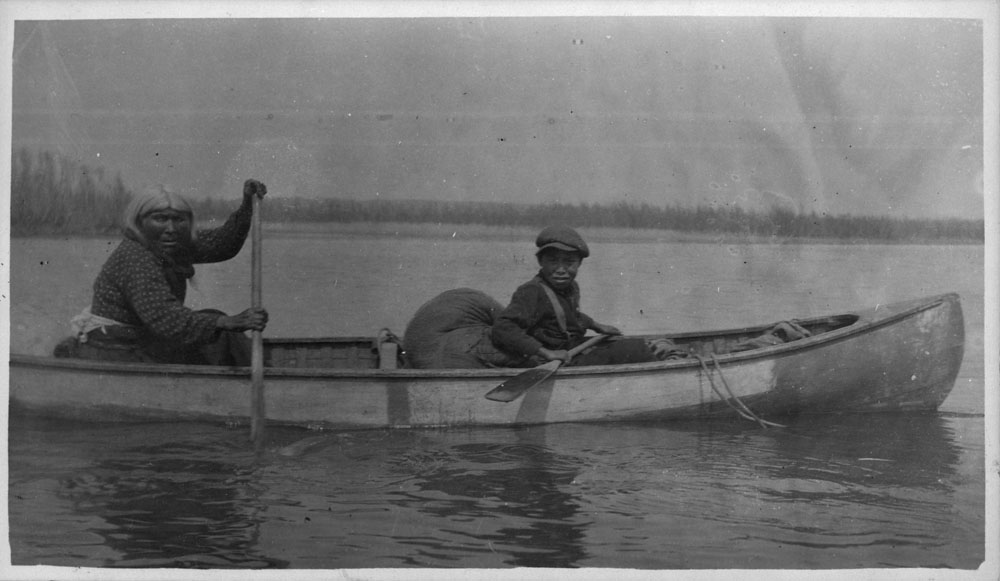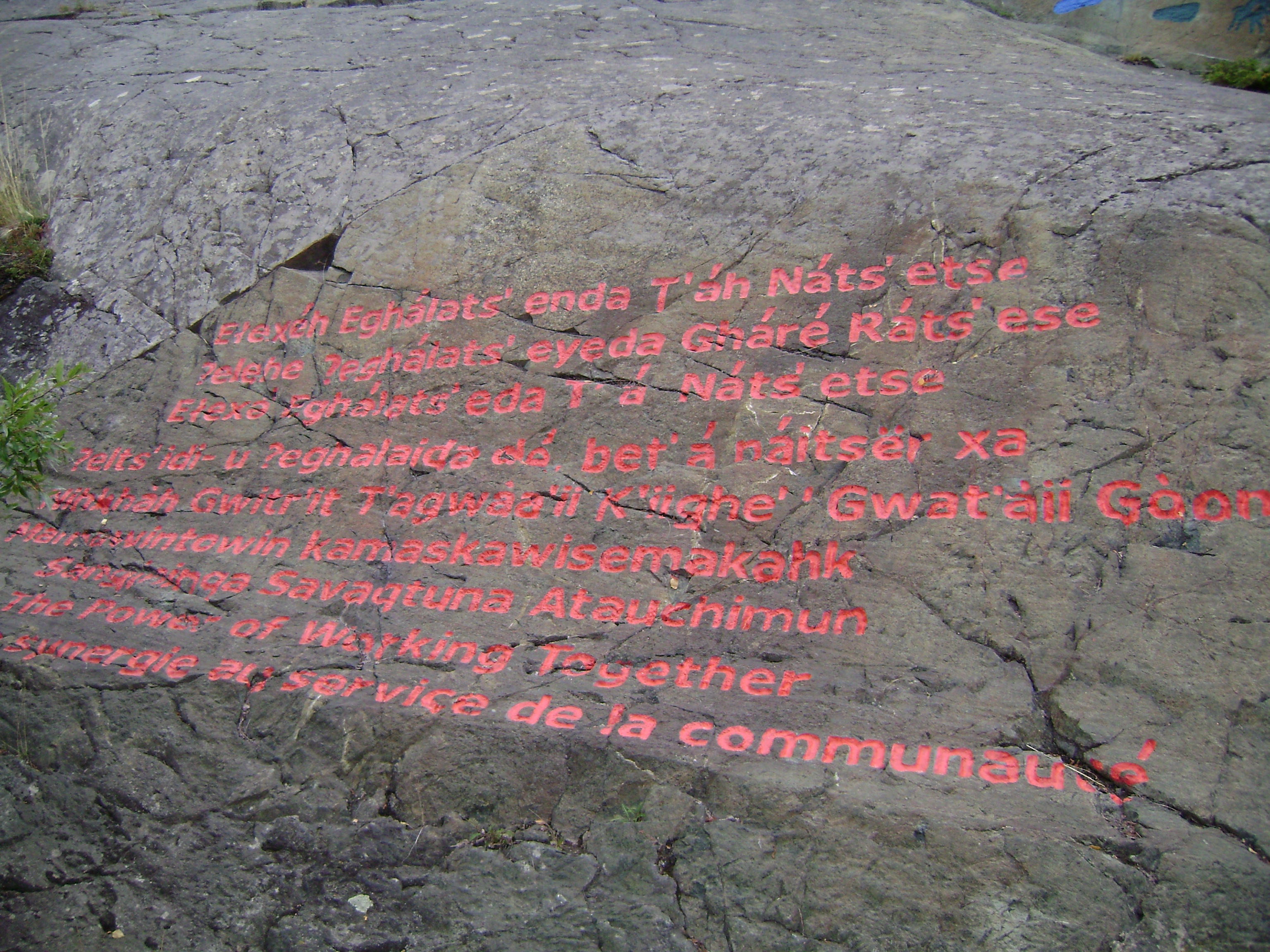|
Northern Athabaskan Language
Northern Athabaskan is a geographic sub-grouping of the Athabaskan language family spoken by indigenous peoples in the northern part of North America, particularly in Alaska (Alaskan Athabaskans), Yukon, and the Northwest Territories. The Northern Athabaskan languages consist of 31 languages that can be divided into seven geographic subgroups. Southern Alaskan : 1. Ahtna (also known as Atna, Ahtena, Copper River) ::* Central Copper River Ahtna ::* Lower Copper River Ahtna ::* Mentasta (also known as Upper Ahtna) ::* Western Ahtna : 2. Dena’ina (also known as Tanaina) ::* Lower Inlet Dena’ina ::: - Outer Inlet ::: - Iliamna ::: - Inland ::* Upper Inlet Dena’ina Central Alaska–Yukon A. Koyukon : 3. Deg Xinag (also known as Deg Hit'an, Kaiyuhkhotana, Ingalik) ::* Lower Yukon River ::* Middle Kuskokwin : 4. Holikachuk (also known as Innoko, Innoka-khotana, Tlëgon-khotana) : 5. Koyukon (also known as Ten’a, Co-Youkon, Co-yukon) ::* Lower Koyukon (also known as Lower ... [...More Info...] [...Related Items...] OR: [Wikipedia] [Google] [Baidu] |
Dene
The Dene people () are an Aboriginal peoples in Canada, indigenous group of First Nations in Canada, First Nations who inhabit the northern Boreal forest of Canada, boreal and Arctic regions of Canada. The Dene speak Northern Athabaskan languages. ''Dene'' is the common Athabaskan word for "people". The term "Dene" has two usages. More commonly, it is used narrowly to refer to the Athabaskan speakers of the Northwest Territories and Nunavut in Canada, especially including the Chipewyan (Denesuline), Tlicho (''Dogrib''), Yellowknives (T'atsaot'ine), Slavey people, Slavey (Deh Gah Got'ine or Deh Cho), and Sahtu (the Eastern group in Jeff Leer's classification; part of the Northwestern Canada group in Keren Rice's classification). However, it is sometimes also used to refer to all Northern Athabaskan speakers, who are spread in a wide range all across Alaska and northern Canada. The Southern Athabaskan speakers, however, also refer to themselves by similar words: Navajo people, D ... [...More Info...] [...Related Items...] OR: [Wikipedia] [Google] [Baidu] |
Upper Tanana Language
Upper Tanana (also known as Tabesna, Nabesna or Nee'aanèegn') is an endangered language, endangered Alaskan Athabaskans, Athabaskan language spoken in eastern Interior Alaska, United States, mainly in the villages of Northway, Alaska, Northway, Tetlin, Alaska, Tetlin, and Tok, Alaska, Tok, and adjacent areas of the Canadian territory of Yukon. In 2000 there were fewer than 100 speakers, and the language was no longer being acquired by children. Overview Upper Tanana shows near mutual-intelligibility with neighboring Tanacross language, Tanacross but differs in several phonological features. In particular, Upper Tanana has low tone as a reflex of Proto-Athabaskan constriction, where Tanacross has high tone. Upper Tanana also has an extra vowel phoneme and has developed diphthongs through loss of final consonants. Traditionally, five main dialects have been recognized. The main Upper Tanana speaking communities today are located in the Alaskan communities of Northway and Tetl ... [...More Info...] [...Related Items...] OR: [Wikipedia] [Google] [Baidu] |
Tsetsaut Language
The Tsetsaut language is an extinct Athabascan language formerly spoken by the now-extinct Tsetsaut in the Behm and Portland Canal area of Southeast Alaska and northwestern British Columbia. Virtually everything known of the language comes from the limited material recorded by Franz Boas in 1894 from two Tsetsaut slaves of the Nisga'a, which is enough to establish that Tsetsaut formed its own branch of Athabaskan. It is not known precisely when the language became extinct. One speaker was still alive in 1927. The Nisga'a name for the Tsetsaut people is "Jits'aawit" The Tsetsaut referred to themselves as the ''Wetaŀ''. The English name ''Tsetsaut'' is an anglicization of , "those of the interior", used by the Gitxsan and Nisga'a to refer to the Athabaskan-speaking people to the north and east of them, including not only the Tsetsaut but some Tahltan and Sekani. Examples The examples by Merritt Ruhlen Merritt Ruhlen (May 10, 1944 – January 29, 2021) was an American ling ... [...More Info...] [...Related Items...] OR: [Wikipedia] [Google] [Baidu] |
Dene Suline Language
Chipewyan or Denesuline (ethnonym: ), often simply called Dene, is the language spoken by the Chipewyan people of northwestern Canada. It is categorized as part of the Northern Athabaskan language family. Dënësųłinë́ has nearly 12,000 speakers in Canada, mostly in Saskatchewan, Alberta, Manitoba and the Northwest Territories.Statistics Canada: 2006 Census Sum of 'Chipewyan' and 'Dene'. It has official status only in the Northwest Territories, alongside 8 other |
Dogrib Language
The Tlicho language, also known as Tłı̨chǫ Yatıì or the Dogrib language, is a Northern Athabaskan language spoken by the Tłı̨chǫ (Dogrib people) First Nations of the Canadian Northwest Territories. According to Statistics Canada in 2011, there were 2,080 people who speak Tłı̨chǫ Yatıì. As of 2016, 1,735 people speak the language. Tłıchǫ Yatıì is spoken by the Tłıchǫ, a Dene First Nations people that reside in the Northwest Territories of Canada. Tłı̨chǫ lands lie east of Mackenzie River (Deh Cho) between Great Slave Lake (Tıdeè) and Great Bear Lake (Sahtu) in the Northwest Territories. There are four primary communities that speak the language: Gamèti (formerly Rae Lakes), Behchokǫ̀ (formerly Rae-Edzo), Wekweètì (formerly Snare Lakes) and Whatì (formerly Lac La Martre). From a population number of about 800 during the mid-19th century to about 1,700 by the 1970s, the population has grown to about 2,080 as recorded by the 2011 Census. Howev ... [...More Info...] [...Related Items...] OR: [Wikipedia] [Google] [Baidu] |
Slavey Language
Slavey (; also Slave, Slavé) is a group of Athabaskan languages and a dialect continuum spoken amongst the Dene peoples of Canada in the Northwest Territories – or central Denendeh – where it also has official status.Northwest Territories Official Languages Act, 1988 (as amended 1988, 1991-1992, 2003) The languages are primarily written using a modified , with some using Canadian Aboriginal syllabics. In their own languages, these languages are referred to as: Sahtúgot’įné Yatı̨́ (spoken by the [...More Info...] [...Related Items...] OR: [Wikipedia] [Google] [Baidu] |
Danezaa Language
Dane-zaa, known in the language as ( syll: ), formally known as Beaver, is an Athabascan language of western Canada. It means "people-regular language." About one-tenth of the Dane-zaa people speak the language. Beaver is closely related to the languages spoken by neighboring Athabaskan groups, such as Slavey, Sekani, Tsuu T’ina, Chipewyan, and Kaska. Dialects The dialects of Dane-zaa language are two main groups. Dialects that developed high tone from stem-final glottalic consonants are called ''high-marked'' and dialects that developed low tone ''low-marked''. From north to south are as follows: *the High-marked Dane-zaa dialects: **Boyer River (Alberta) dialect is spoken by members of the Beaver First Nation ** Child Lake (Alberta) dialect is spoken by members of the Beaver First Nation **Prophet River (British Columbia) dialect is spoken by members of the Prophet River First Nation ** Blueberry River (British Columbia) dialect is spoken by members of the Blueberry River ... [...More Info...] [...Related Items...] OR: [Wikipedia] [Google] [Baidu] |
Sekani Language
The Sekani language or Tse’khene is a Northern Athabaskan language spoken by the Sekani people of north-central British Columbia, Canada. Phonology Consonants Sekani has 33 consonants: Vowels Tone Sekani has two tones: low and high. High tone is the more common tone. Syllables phonologically marked for tone are low. Nasalization Nasalization of vowels is phonemic and so changes the meaning. Sample words In the practical writing system used here for the Kwadacha Tsek'ene dialect, ''u'' represents the mid-central vowel, and ''oo'' represents the high back rounded vowel. An apostrophe represents a glottal stop, and an ogonek The (; Polish: , "little tail", diminutive of ) is a diacritic hook placed under the lower right corner of a vowel in the Latin alphabet used in several European languages, and directly under a vowel in several Native American languages. It i ... under a vowel represents nasalization. *dune man; person *tlįį dog *wudzįįh caribou *yus snow ... [...More Info...] [...Related Items...] OR: [Wikipedia] [Google] [Baidu] |
Kaska Language
The Kaska language originated from the family of Athabaskan languages. Traditionally Kaska is an oral aboriginal language that is used by the Kaska Dena people.Farnell, G. (2014). The Kaska Dene: A study of Colonialism, Trauma and Healing in Dene Kēyeh. The University of British Columbia/ref> The Kaska Dene region consists of a small area in the Southwestern part of the Northwest Territories, the Southeastern part of Yukon Territory, and the Northern part of British Columbia. The communities that are in the Kaska Dene region are Fort Ware in N.W.T.; Ross River and Watson Lake in Y.T.; Dease Lake, Good Hope Lake, Lower Post, Fireside, and Muncho Lake in B.C. Kaska is made up of eight dialects, all of which have similar pronunciations and expressional terms. The town of Watson Lake was established around the period of the second World War when the Alaska Highway was first built in 1942. A major consequence of colonization was Kaska language loss. Another major cause of Kaska la ... [...More Info...] [...Related Items...] OR: [Wikipedia] [Google] [Baidu] |
Tahltan Language
Tahltan, Tāłtān, also called Tałtan ẕāke ("Tahltan people language"), dah dẕāhge ("our language") or didene keh ("this people’s way") is a poorly documented Northern Athabaskan language historically spoken by the Tahltan people (also "Nahanni") who live in northern British Columbia around Telegraph Creek, Dease Lake, and Iskut. Tahltan is a critically endangered language.Alderete, John forthcomingOn tone length in Tahltan (Northern Athabaskan) In: Hargus, Sharon and Keren Rice (eds.): ''Athabaskan Prosody''. Amsterdam/Philadelphia: John Benjamins. Several linguists classify Tahltan as a dialect of the same language as Tagish and Kaska (Krauss and Golla 1981, Mithun 1999). Language revitalization As of May 2013, language researcher Dr. Judy Thompson estimated that there are 30 Tahltan speakers. A new Language and Culture office is exploring evening "language immersion" classes, a Master-Apprentice program, and creating a "language nest" for teaching the language to y ... [...More Info...] [...Related Items...] OR: [Wikipedia] [Google] [Baidu] |
Tagish Language
Tagish was a language spoken by the Tagish or Carcross-Tagish, a First Nations people that historically lived in the Northwest Territories and Yukon in Canada. The name Tagish derives from ''/ta:gizi dene/'', or "Tagish people", which is how they refer to themselves, where ''/ta:gizi/'' is a place name meaning "it (spring ice) is breaking up.Yinka Déné Language Institute. (2006). The Tagish Language. https://www.ydli.org/langs/tagish.htm The language is a Northern Athabaskan language, closely related to Tahltan and Kaska. The three languages are often grouped together as Tahltan-Kaska-Tagish; the three languages are considered dialects of the same language by some.Alderete, J., Blenkiron, A., &Thompson, J. E. (2014). Some notes on stem phonology and the development of affricates in Tahltan (Northern Athabaskan). Ms., Simon Fraser University and Northwest Community College. As of 2004, there was only 1 native fluent speaker of Tagish documented: Lucy Wren (Agaymā/Ghùch Tlâ).Gr ... [...More Info...] [...Related Items...] OR: [Wikipedia] [Google] [Baidu] |


